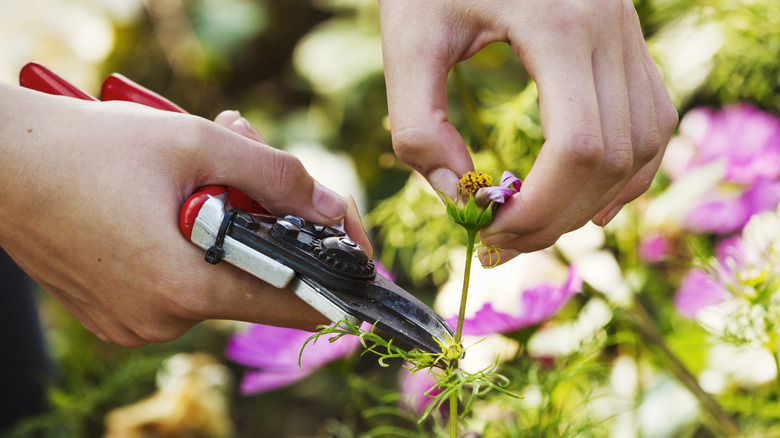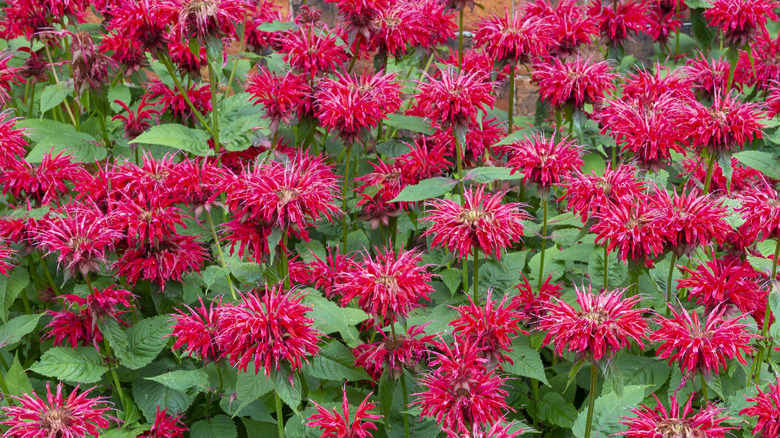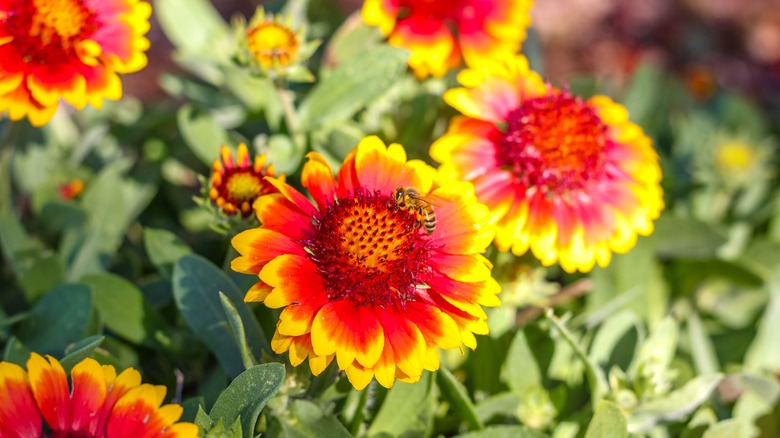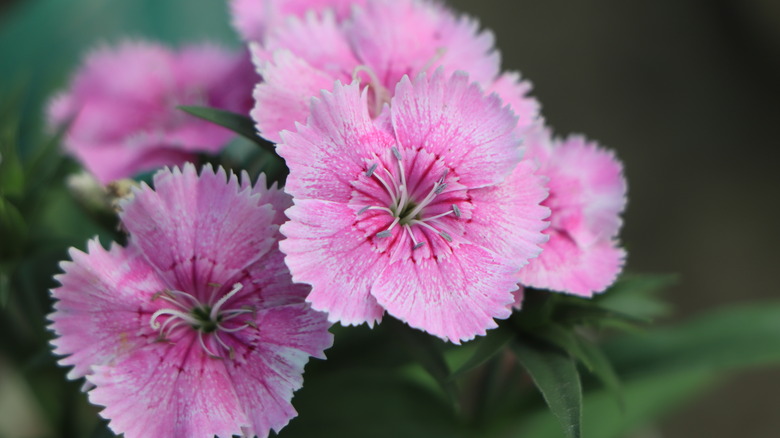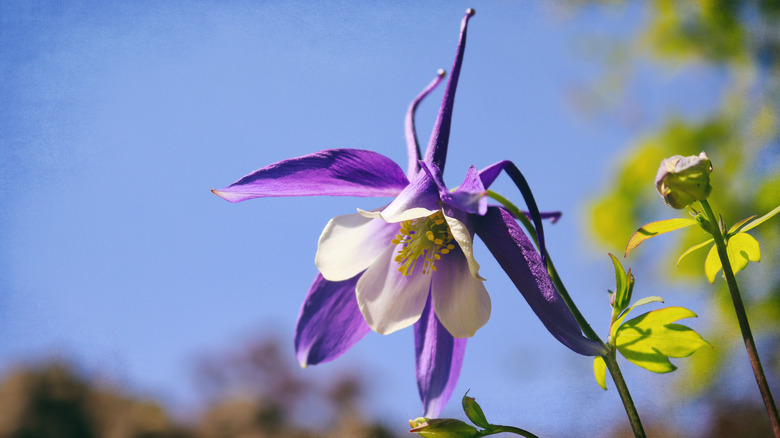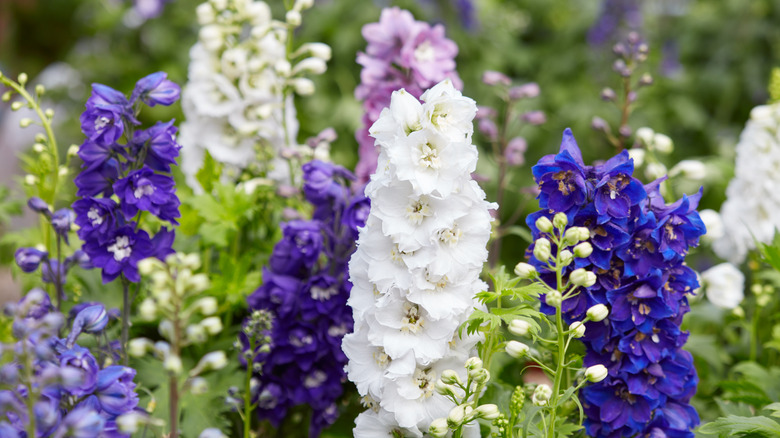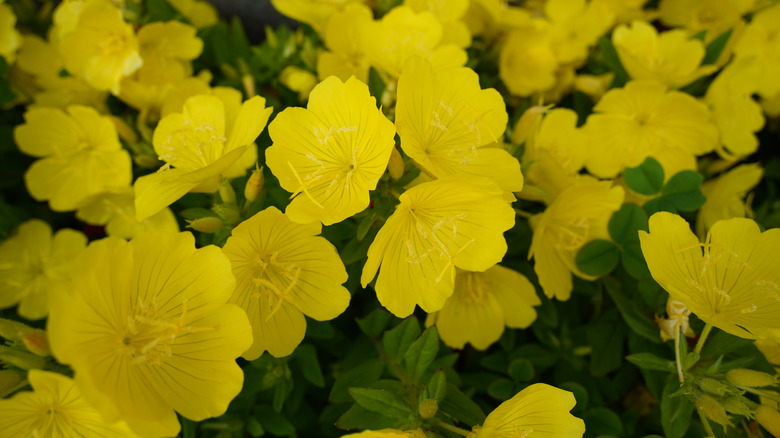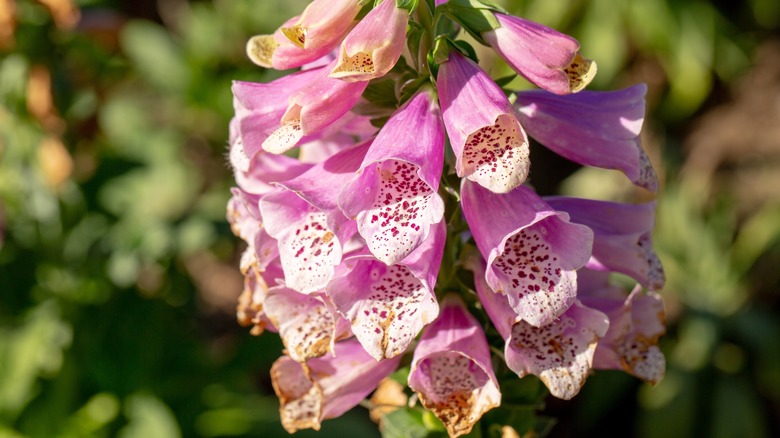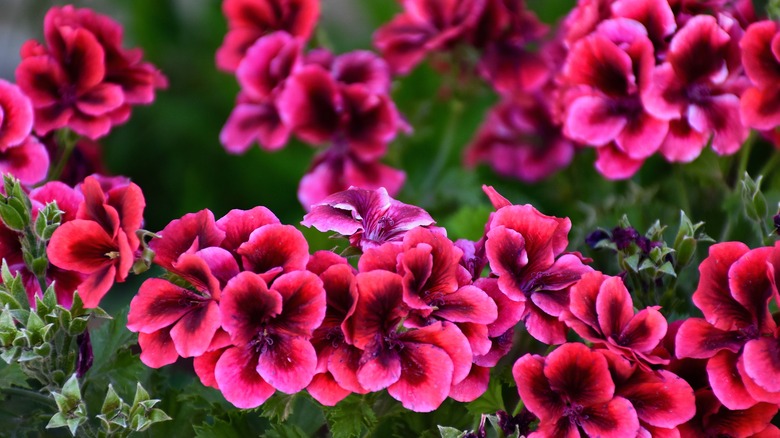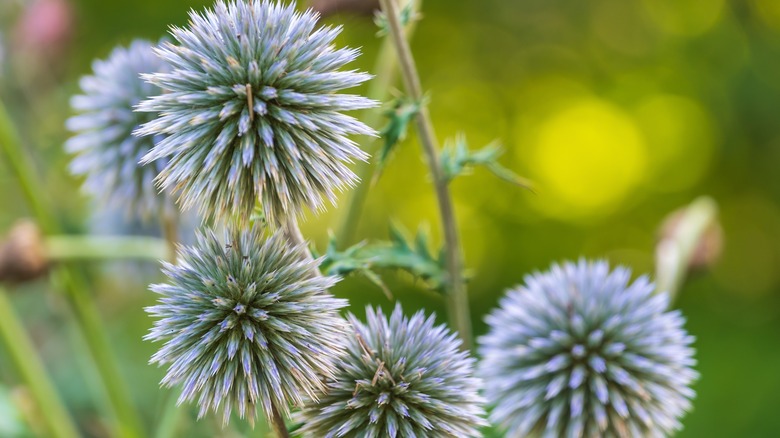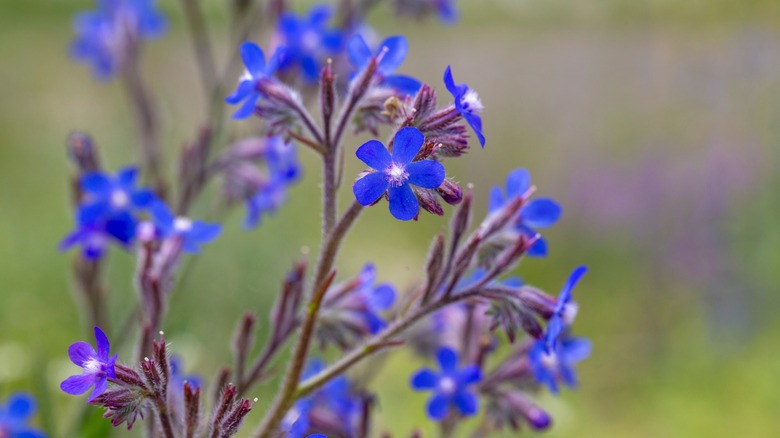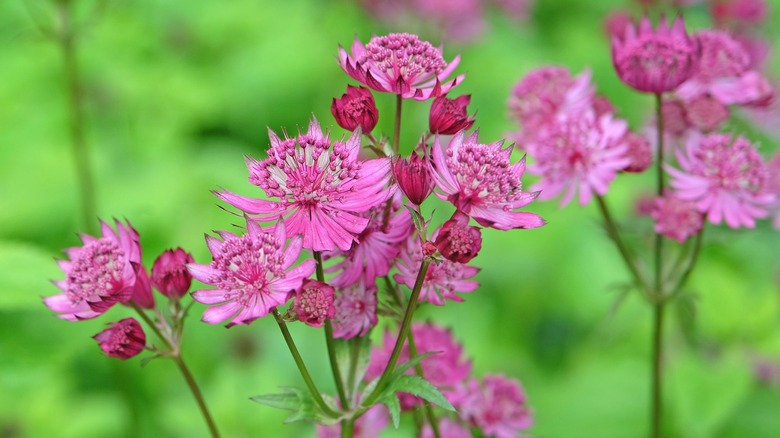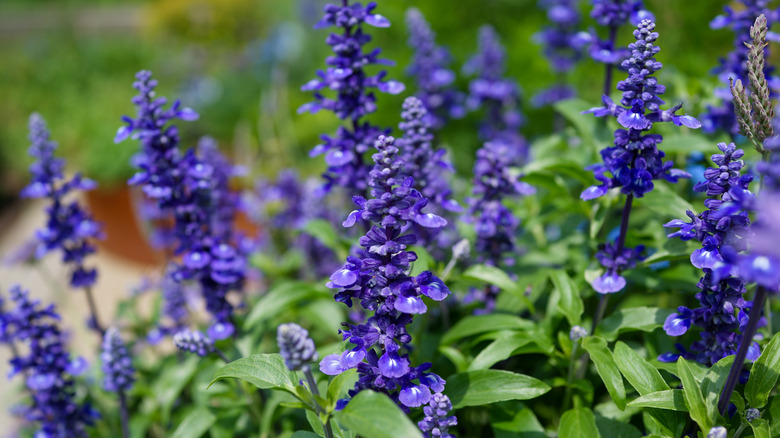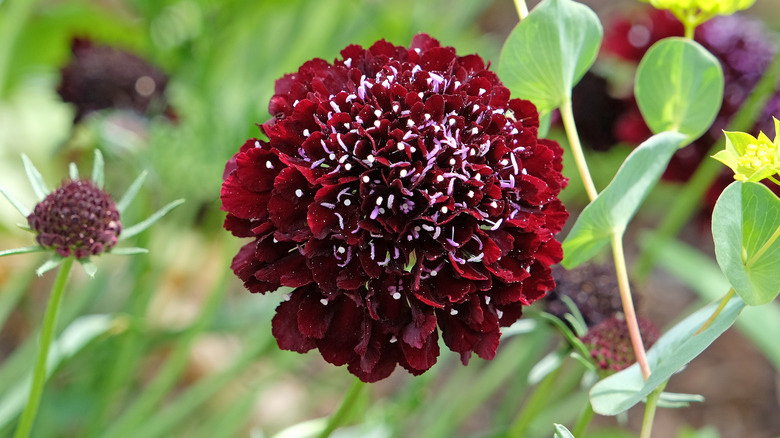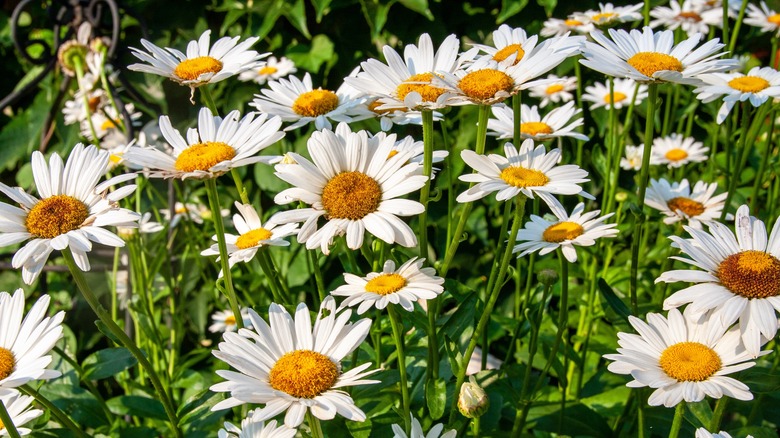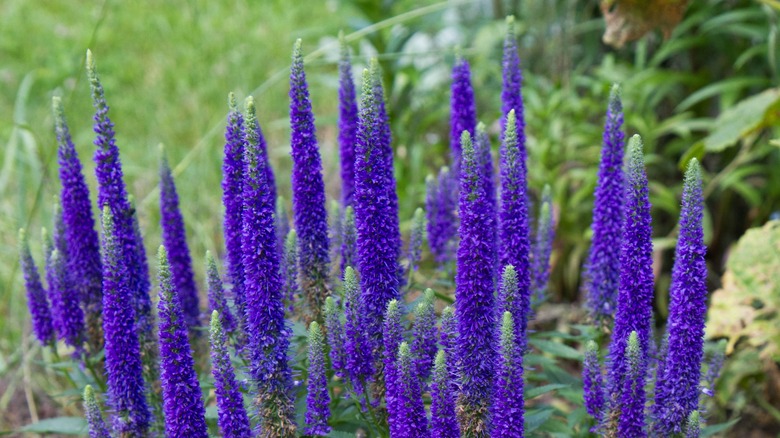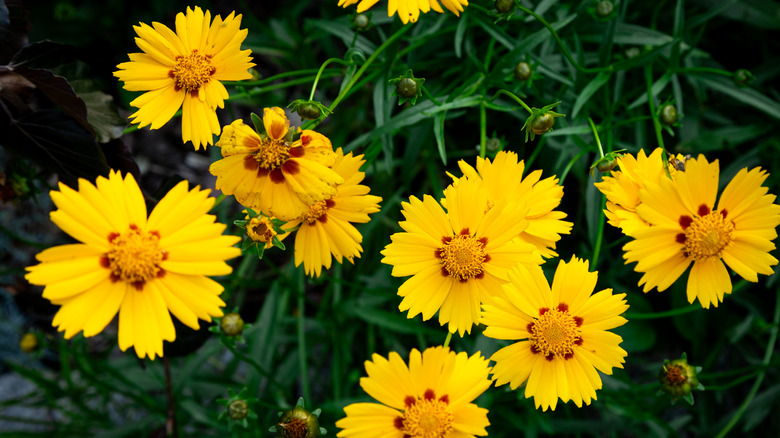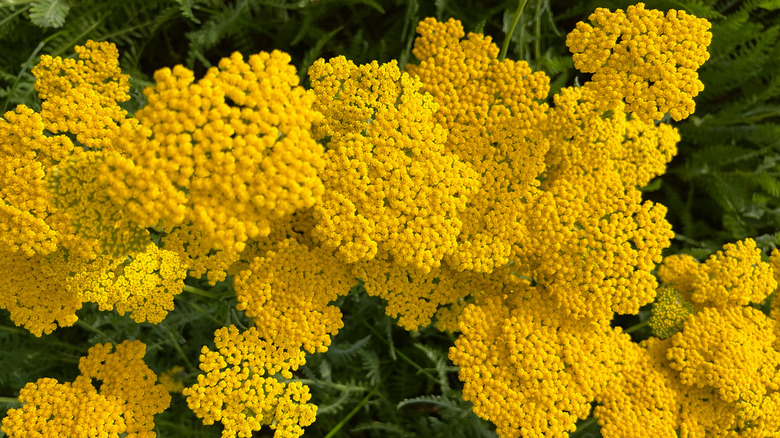19 Perennials You Should Deadhead For Blooms That Keep Coming
Deadheading in your garden is a must for many perennials that can not only improve the appearance of the plant throughout the season but also encourage the plant to produce more blooms. However, it isn't recommended for all perennials. The process involves pinching off flowers that have begun to die to keep the plant from looking disheveled, stop it from self-seeding, avoid petals from spreading, and encourage new blooms. For plants that produce seeds for birds, those you want to save seeds for next year, or plants that do not rebloom, you want to avoid deadheading.
Generally, you can deadhead any time in the season if you notice flowers that are looking like they may be spent. But, it may be possible to deadhead too much. In some varieties, you may only need to deadhead a few times, or even just once. Depending on the plant, you will want to either pinch off the flower heads with your fingers or clip them off with sharp pruning shears. Shasta daisies, columbine, and geraniums are among the list of perennials you should deadhead for blooms that keep coming.
Bee balm
Bee balm (Monarda didyma) is known by many names, including bergamot and horsemint. It is an aggressive, but non-invasive, flower that grows in USDA Hardiness Zones 4 to 9. When caring for your bee balm plant, deadheading will allow your plant to re-bloom later in the same season. You can do this as often as you want throughout the season, as soon as you notice flowers starting to wilt. Deadhead spent flower stems by using sharp pruning shears.
Blanket flower
The blanket flower (Gaillardia) grows in zones 3 to 9, and it can become weedy in some regions if not cared for properly. This flower is easy to grow and has a long-blooming season, which you can extend further by deadheading. Once per week, use shears to snip spent flowers off at the first leaf node. When the season is coming to a close, you can leave the spent flowers, allowing them to seed to attract finches and butterflies to your garden.
Cheddar pinks
The England-native cheddar pinks (Dianthus gratianopolitanus) are a non-invasive species that grows in zones 4 to 8. This fast-growing ground cover that butterflies love usually blooms between May and June, but the blooming season can be extended into the summer with regular deadheading. Using sharp pruning shears or scissors, cut the stem down to just above the first healthy leaves. For better growth and healthier blooms, cut at a 45-degree angle.
Columbines
A great plant for attracting pollinators, but remaining resistant to deer and rabbits, is the columbine (Aquilegia) plant. It is a self-seeding plant that grows in zones 3 to 8. Deadheading can extend your blooming season up to 6 weeks. The best time to deadhead your columbines depends on whether you are trying to promote reblooming or collect seeds. You can deadhead any time you see flowers wilting to promote regrowth. There is no preferred method for deadheading columbines; you can pinch or cut them anywhere below the head of the flower.
Delphinium
Delphiniums, also called larkspur or staggerweed, are non-invasive flowers that bloom on elongated clusters in hardiness zones 3 to 9 (USDA). To help this stunning perennial produce colorful blooms multiple times a year, you should deadhead any time you see wilting flowers by cutting off the entire cluster from the shoot. Use sharp shears to cut it down to the foliage. For delphiniums, deadheading is not optional; it is an essential part of the plant's maintenance and care.
Evening primrose
Evening primrose (Oenothera biennis) is a wildflower that grows in hardiness zones 4 to 8. It can be somewhat weedy in certain regions, so take care to check with local authorities before planting. However, because it spreads by self-seeding, deadheading can prevent it from growing wildly. For sustained growth and regular blooming, deadhead using your favorite method as soon as the flowers begin to wilt.
Foxgloves
Deadheading is an important part of successfully growing foxglove (Digitalis purpurea). This flower is considered invasive or a noxious weed in some regions, so check locally before planting in zones 4 to 9. In other areas, it's great for attracting pollinators while deterring deer and rabbits. The main reason to deadhead foxglove is to prevent it from spreading to other areas of the garden. However, it also helps promote regrowth in the current season. When about 75% of the flowers have wilted, use sharp shears to cut the spikes down to the foliage.
Garden phlox
You will want to deadhead your garden phlox (Phlox paniculata) to make it a powerhouse in late summer gardens. This non-invasive perennial grows in hardiness zones 4 to 8. The flowers bloom in clusters at the top of the stems, making them attractive to pollinators, including hummingbirds. Deadheading is done on garden phlox to prevent wild seeding and to extend the blooming season while keeping the plant tidy. Use small, sharp scissors to cut dying flowers off just above new buds on the stem.
Geranium
Geraniums (Pelargonium spp.) grow in zones 10 to 11 and come in a range of colors, including red, orange, pink, and white. These are another perennial that requires deadheading as part of their regular maintenance and care. To deadhead your geraniums, you can use your fingers to pinch off spent flowers. You can also use shears or scissors to cut the deadhead, but it is not necessary. The cut can be made anywhere below the bloom cluster, and you can deadhead at any time of the season.
Globe thistles
Globe thistles (Echinops ritro) are a round, steel-blue perennial that grows in zones 2 to 8. It is a non-invasive species that is generally used to attract pollinators, particularly bees, to a garden. Normally, deadheading is done to prevent self-seeding, but if you cut the stems down to the basal foliage, it can promote reblooming. You can cut back flowers as they die with sharp pruning shears to encourage regrowth, but don't prune completely until the spring.
Italian Bugloss
The decorative and edible Italian bugloss (Anchusa azurea) is often grown in Mediterranean gardens. It is a non-invasive perennial that grows in zones 3 to 8. However, it is a self-seeding plant, so if left alone, it can spread quickly, which is one of the reasons gardeners tend to deadhead it. It will rebloom after deadheading so you can extend the blooming season from mid-summer to late summer. You will likely only need to deadhead once in the season after the first blooms begin to die. Use sharp pruning shears to cut the stems down to the basal foliage.
Masterworts
Masterworts (Astrantia spp.) grow in zones 4 to 7 and are usually used as border flowers for wildflower or cottage gardens to attract pollinators in the fall. For these perennials, it is not necessary to deadhead for regular care and maintenance because, even though they self-seed, they do not spread wildly. They are non-invasive, spreading in small clusters. However, you can deadhead them once per season after the first blooms die to encourage a second blooming period. Use sharp scissors or shears and snip the stems off at the base.
Roses
Roses (Rosa spp.) are one of the most recognizable blooms in any flower garden –- or flower shop for that matter. There are many varieties which grow in zones 5 to 11. One of the most common gardening mistakes to avoid to get more blooms from your roses is not deadheading. Not every variety needs to be deadheaded, but for those that do, like hybrid tea, floribunda, and grandiflora, use sharp pruning shears to cut the stem about ¼ inch above new buds at a 45-degree angle.
Salvia
There are two common reasons to grow plants in the Salvia genus, also known as sage. Most people are familiar with sage as an herb that is commonly found in kitchens and aromatics, but there are also some that are also grown in flower gardens for their beautiful purple blooms. They grow in zones 5 to 10 but note that some varieties are invasive in certain regions. For regular blooming all season long, deadhead whole spikes using your favorite method throughout the blooming season, leaving them to go to seed at the end of the season if you want more plants.
Scabiosa
Scabiosa (Scabiosa atropurpurea), also commonly called the pincushion flower, produces clusters of long-stemmed blooms in a variety of colors, including blue, yellow, pink, purple, red, and white. They grow in zones 4 to 11. Deadheading isn't required to care for your pincushion flowers; however, it will definitely encourage reblooms. You can simply cut spent flowers down to the foliage with sharp shears.
Shasta daisy
Shasta daisies (Leucanthemum x superbum) grow in zones 4 to 9. They tend to freely reseed and may take over your garden, which is why deadheading is an essential part of caring for your Shasta daisies – to prevent seeds from spreading at the end of the season. Plus, it can extend the blooming season so they produce blooms from June to September. When the blooms brown, about twice per season, cut spent blooms at leaf pairing with sharp pruning shears.
Spiked Speedwell
There are over 250 varieties of speedwell (Veronica) flowers, some of which are invasive. However, the spiked speedwell (Veronica spicata) is a non-invasive speedwell flower that grows in zones 3 to 8. You don't need to deadhead your spiked speedwell, but it will help it rebloom and extend the season well into the fall. Use sharp shears to cut spent flowers down at the base of the stem by the foliage.
Tickseed
While tickseed (Anacis major) is a low-maintenance perennial that hardly needs any attention to thrive, deadheading helps control self-seeding to prevent overgrowth. You will also reap the benefits of a longer blooming season. It grows in zones 5 to 9 in sandy soils. You don't need to do it every time you see dead flowers, but once a week or so, use shears to cut the head off. You can cut the stems down to keep it tidy.
Yarrow
Yarrow (Achillea) is a useful plant that is both beautiful in a flower garden and valuable as a medicinal herb. Deadheading can help control yarrow and manage the spread. It will also ensure new blooms to extend the flowering season. You may want to wear gloves when pruning yarrow to avoid any potential skin reaction. Use sharp shears to cut below the spent flowers but above new buds.
